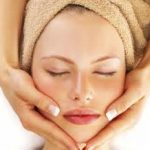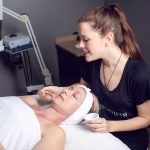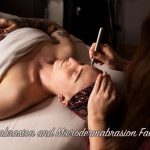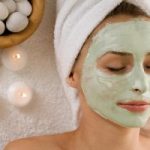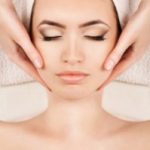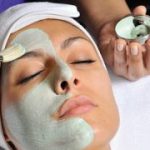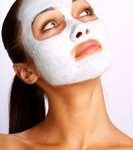Facials for problem skin: what to look for
The following are key components of a good problem skin facial or acne facial.
1. Skin analysis
Your esthetician should examine your skin closely under magnification and discuss with you what you’re using on your skin daily, in detail. Like a detective, your esthetician tries to piece together the culprits for your breakouts. They may not be the usual suspects, especially if you have Adult Onset Acne. You may have enjoyed clear skin all your life, even avoided teenage acne, and suddenly find yourself breaking out, for no apparent reason. Adult Onset Acne is harder to clear than teen acne, which is very straightforward.
Regardless of your age, acne is never the result of just one factor, such as excess oil or bacteria. It’s almost always a combination of issues, and each one must be addressed in order to get your skin clear.
Your esthetician will evaluate the type of eruptions and impactions you have. For example, you can have very clogged pores but no breakouts. Or you can have breakouts that seem unrelated to any pore impactions. Then again, you may have classic clogged-pores-with-breakouts. This is one of the easiest problems to treat; clearing your pores will usually end your breakouts.
2. Exfoliation
For someone with clogged pores, a deep exfoliation is the first step in loosening the debris that is blocking the follicle. Skin cells have an adhesive property that enables them to cling to the surface of the skin. The protective “horny layer” forms the outermost layer of the skin. Your pores are not holes in the skin; they’re tiny indentations on its surface. That’s why this layer of sticky surface cells is present inside the pores as well. And if you have clogged pores, you’re cursed with extra-sticky skin cells, which clump together inside the pores, forming impactions that block the natural flow of oil out of the pore. Acne bacteria show up to feast on this oil.
Sometimes “super sticky” skin cells are caused by your own skin’s adhesive properties, and sometimes it’s caused by the products you apply to the skin. If this is the cause of your acne, you have an easy-to-remedy condition called acne cosmedica. It’s simply a matter of figuring out which product in your routine is gumming up your pores. Usually, it’s your moisturizer or sunscreen.
Exfoliation can be accomplished with an enzyme that dissolves dead skin cells (fruit enzymes from papaya and pineapple do this.) A more intensive way to do this is with an alpha hydroxy or beta hydroxy acid peel. Scrubs are a crude way to exfoliate and tend to cause more inflammation and irritation for acne conditions. The use of AHA/BHA formulas at home will help the cells on the follicle wall continue to slough off. A serum with a combination of salicylic acid and glycolic acid produces an excellent synergistic effect.
Benzoyl Peroxide (BPO) also helps to keep the follicles free of debris, and it kills the anaerobic bacteria which cause acne by introducing oxygen. Contrary to popular belief, you don’t need to use high concentrations of BPO to clear your skin.
3. Proper massage technique
For true acne conditions, the less friction the better, but there are massage techniques, including Manual Lymphatic Drainage and a manipulation called Jacquet (a gentle pinching/rolling) that are beneficial. They help to detoxify the skin. As an excretory organ, the skin is responsible for evacuating waste. Sluggish skin, sometimes referred to as “asphyxiated” skin, needs a bit of encouragement. If your skin texture is normal to thick, and your pore impactions resemble “waxy yellow buildup,” you’ll probably respond well to massage. When dealing with inflamed acne, most skincare experts omit facial massage altogether.
4. Proper extraction technique
Expert extraction is essential to clearing problem skin, but few estheticians employ the proper technique. It must be precise and targeted to the “offending” pore. For example, most estheticians wrap their fingers in gauze, cotton, or tissue and simply squeeze the area around a pore–hard. This is the exact wrong thing to do to the skin in which there are inflamed pustules. The walls of these inflamed pores are compromised and weak from the infection, and squeezing can cause them to rupture, spilling bacteria-laden debris into the deep, living layers of the skin. When this happens, your skin will form “tombstone scars,” trapped pockets of infection buried deep in the skin that periodically re-inflame as stubborn, painful bumps. They can never be extracted and they will haunt you for years (hence the name.)
Squeezing is also poor physics unless you’re dealing with large, open pores such as those on the nose. When you’ve had squeeze-style extractions, you’ll notice that the skin sloughs like mad around the extracted areas in a couple of days. That’s because the pressure of the squeezing literally pulls away from the upper layer of skin and causes it to peel off.
Good extraction technique is about precision, applying the right amount of pressure at exactly the right spot. At Precision Wellness we use a special surgical steel extractor that can address one pore at a time. This is not the big, crude comedone extracting “loop” or “dish with the hole in it”, but has a very tiny curve that is placed around the clogged pore. Then the debris is pushed, from the back of the pore to the front, guiding it toward the “exit.” This enables the complete evacuation of the comedone.
If you find that you break out after facials, the culprit is usually improperly performed, or incomplete, extractions. If the esthetician breaks up a comedone while extracting it, the remaining debris in the pore will run wild, creating a blemish.
If an esthetician ever tells you that you’re supposed to break out after a facial, run, don’t walk, in the opposite direction. The classic claim is that post-facial breakouts are “impurities coming to the surface.” Believe me, your skin excretes impurities and waste all day long–that’s what it’s designed to do. It does not have to erupt to cleanse itself. It is possible to overstimulate the skin during a marathon extraction session, and every esthetician has done this at one time or another, but that’s not the right outcome. If you’ve had a lot of extractions, we’ll often advise putting an ice cube in a plastic bag and massaging the skin during the hours after the treatment. You can also mask your skin again the following day to help sedate it further.
5. Calming and sedating
After extracting comedones, it’s good to give the skin a chance to calm down.
Many skins will also benefit from a quick pass with a high-frequency electrode. This elongated glass tube, which glows blue to violet and makes an unsettling buzzing sound, looks like something straight out of science fiction, but it works wonderfully. The esthetician can actually create a “spark gap” between a blemish and the electrode to zap it, destroying bacteria. And yes, that little zap feels not-so-relaxing–don’t worry, we’ll warn you. Not everyone prefers to “nuke” their blemishes with high frequency, but it really works.
6. Recommend the proper home care regimen
No matter how good the facial treatment is the key to clearing skin is using the right home care regimen. This is the product that touches your skin daily.
7. Recommend the right interval, right length facial treatment program
Any time you want to change the behavior of your body, you have to repeatedly challenge or treat it, over a period of time. Imagine trying to get in shape by working out once a month, and you’ll have an idea of how unrealistic it is to think that a periodic facial, without a proper home, can clear acne. Don’t be surprised if your esthetician asks you to come in once a week for four to six weeks when you kick off your skin clearing project. The good news is that once you’ve gotten control of your skin, you can drop back to a maintenance schedule that may be as little as once a month. But you have to do your part, and stick to your regimen at home.
It takes a comedone (blackhead) 90 days to form. That means you should allow at least 90 days to cycle through all the existing, built-up debris and get your skin cleared, but professional treatments really accelerate this process. The more you participate–masking at least twice a week, using your home care faithfully, and following our clear skin guidelines–the faster you’ll see results.


